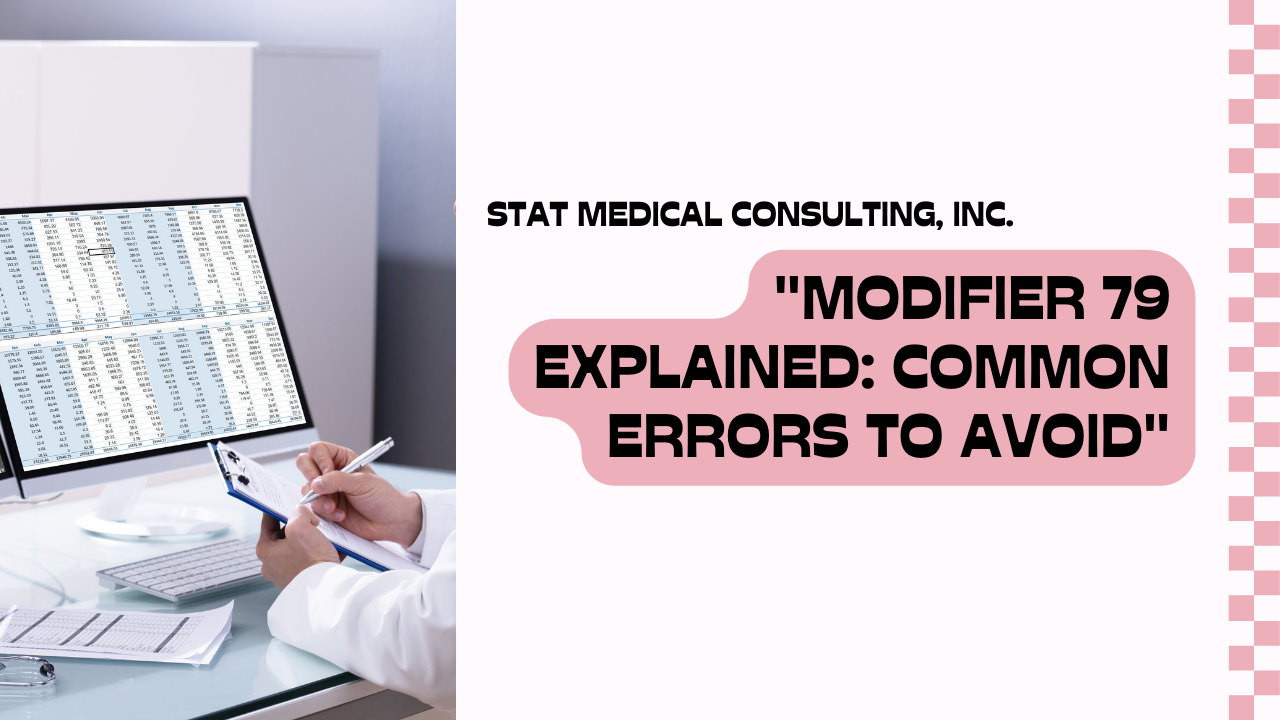TEL: (818) 907-7828 | EMAIL: sharon@statmedical.net
Mastering Denial Management in Medical Billing
Mastering Denial Management in Medical Billing
A Complete Guide for Healthcare Practices
In the fast-evolving world of healthcare, managing claim denials is no longer just about fixing errors — it’s about preventing revenue loss before it happens. As billing complexity grows and payer policies shift frequently, denial management in medical billing has become a strategic pillar for sustainable practice operations.
In this comprehensive guide, we’ll break down everything you need to know about denial management — from common causes to effective solutions — while weaving in real-world practices to help you take control of your revenue cycle.
What is Denial Management in Medical Billing?
Denial management refers to the systematic process of identifying, analyzing, correcting, and ultimately preventing denied claims submitted to insurance providers. It’s more than just resubmitting claims — it’s about digging into the “why” and building workflows to fix the root causes.
In a typical
billing cycle, a claim might get denied for something as simple as a typo or as complex as a misinterpreted payer guideline. Without an active denial management strategy, these rejections can quietly drain your revenue and productivity.
At its core, denial management bridges the gap between care delivered and payment received. It ensures that every valid service rendered gets reimbursed — and that denials don’t become a recurring headache.
Common Types of Denials in Medical Billing
Not all denials are the same. They fall into two major categories:
- Soft Denials: Temporary and often fixable (e.g., missing data or documentation). These can be corrected and resubmitted.
- Hard Denials: Permanent rejections that result in revenue loss and cannot be corrected or appealed (e.g., expired eligibility).
Understanding the distinction helps billing teams prioritize and triage denials accordingly.
Top Reasons Why Claims Get Denied
Getting ahead of denial management means knowing where things typically go wrong. Here are the most common culprits:
- Inaccurate or Incomplete Patient Information: Even minor errors in patient demographics, policy numbers, or spelling mistakes can trigger a denial.
- Authorization and Precertification Lapses: Missing prior authorizations or failing to document medical necessity can easily lead to rejection.
- Coding Errors or Inconsistencies: Wrong CPT/ICD-10 codes, unbundling, or outdated modifiers can all disrupt clean claim submission.
- Duplicate Claims: Accidentally submitting the same claim twice often triggers automatic denial filters.
- Timely Filing Violations: Insurance companies impose strict deadlines. Submitting even a day late can nullify your payment rights.
- Non-Covered Services: Services rendered that fall outside of the patient’s coverage plan or payer contract terms.
By staying vigilant at each touchpoint in the billing cycle, most of these issues can be caught before the claim ever reaches the payer.
Why Denial Management Matters to Your Bottom Line
Denials aren’t just paperwork problems — they directly impact revenue. According to industry reports, one out of every five claims gets denied on the first submission, and reworking each denial costs around $25–$118 depending on the practice size.
Here’s what’s at stake:
- Cash Flow Disruptions: Denials delay payments, increasing your accounts receivable days and creating unpredictable revenue patterns.
- Increased Administrative Workload: Reworking and resubmitting claims eats up hours that could be spent on higher-value tasks.
- Lost Revenue Opportunities: Up to 65% of denied claims are never reworked, which means missed reimbursements for care already delivered.
- Patient Frustration: Denials can also affect patient trust, especially if they lead to unexpected bills or prolonged claim disputes.
Developing a Fully Integrated Denial Management Strategy
Denial management is no longer just a back-office task for resolving rejected claims — it’s a foundational component of a healthy revenue cycle. To truly minimize the financial and administrative impact of denied claims, healthcare organizations need a strategy that is not only reactive but also highly preventive, proactive, and system-driven. The most successful denial management approaches are holistic. They don’t simply chase rejections after they happen; they work across departments, align teams, and use technology and data to reduce denials at every stage — from the moment a patient is scheduled to the final payment posting.
Start with a Strong Framework
The first step toward building a robust denial management strategy is establishing a clear operational framework. This means assigning accountability to a specific denial team or cross-functional task force, mapping out workflows, and ensuring communication pathways exist between billing, coding, clinical, and administrative teams. Everyone involved in the revenue cycle should have visibility into denial data, trends, and root causes. Without shared understanding, even the best technology or billing platform won’t solve recurring issues.
Strengthen Front-End Processes
One of the most critical areas to address is the front end. Many denials originate long before the claim is submitted — during scheduling, registration, or insurance verification. Simple oversights like entering incorrect policy numbers, missing authorizations, or failing to confirm eligibility can result in preventable rejections. Strengthening these early touchpoints through rigorous staff training and real-time eligibility tools can significantly reduce denials. A culture of accuracy at the front desk sets the tone for clean and compliant billing.
Improve Documentation and Coding
Accurate documentation and coding are essential for successful claim reimbursement. Poor clinical notes or incomplete documentation can lead to denials for lack of medical necessity or unsupported diagnoses. This is particularly common in specialty care, where payer policies vary and are often complex. Encouraging stronger collaboration between providers and coders is key. Ongoing training, regular audits, and clear documentation guidelines all contribute to reducing coding-related denials. Coders should also be equipped with technology that flags potential errors before submission.
Use Technology to Prevent and Track Denials
Technology is a powerful ally in denial prevention. By integrating denial management tools with your EHR and billing systems, you can scrub claims in real time, flag inconsistencies, and validate data against payer-specific rules before submission. Advanced systems use artificial intelligence and predictive analytics to highlight high-risk claims and suggest proactive steps. Dashboards can offer insights into denial patterns, timelines, and resolution statuses, making it easier to optimize your approach. Automation can also speed up appeals and streamline follow-ups with payers.
Centralize Denial Handling and Appeals
When denials occur — and they will — a centralized work queue helps prevent delays and missed appeal deadlines. Organizing and prioritizing denied claims based on value, type, and payer response timelines ensures that nothing slips through the cracks. In addition, developing standardized appeals processes is critical. Templates for common denial types, pre-written appeal letters, and protocols for attaching supporting documents can dramatically improve both efficiency and success rates when responding to payers.
Monitor Performance and Encourage Feedback Loops
To keep your denial management strategy effective, you must continuously measure and refine it. Track KPIs such as denial rates, first-pass claim acceptance rates, appeal turnaround time, and rework costs. Analyze this data regularly and use it to adjust policies, training efforts, and workflows. Just as important is building feedback loops across departments. When front-office staff, billing teams, and providers are all aware of where denials are occurring and why, they can make informed changes that reduce the chances of repeated issues.
A Culture of Continuous Improvement
Ultimately, denial management isn’t just a workflow — it’s a mindset. Practices that embed accuracy, transparency, and accountability into every stage of the billing process are the ones that see fewer denials, faster reimbursements, and better financial health. With a comprehensive strategy in place, supported by collaboration and smart use of data, healthcare organizations can move away from reactive fixes and toward long-term revenue stability.
Technology: The Game Changer in Denial Prevention
Manual processes can only take you so far. With billing complexity rising, technology is now essential for efficient denial management.
Tools That Make a Difference:
- EHR + Billing Integration: Seamless flow of data reduces mismatches and minimizes human error.
- Predictive Analytics: AI tools can analyze historical denial data and flag high-risk claims before submission.
- Automated Rules Engines: Validate claims in real time against payer rules before they're submitted.
- Appeals Management Software: Pre-built templates, tracking systems, and auto-generated letters improve success rates.
Practices using tech-driven denial management often see a 20–30% reduction in denial rates and faster revenue realization.
Best Practices for Long-Term Denial Reduction
Want to keep denials at bay for good? Here are a few sustainable habits to adopt:
- Audit regularly – Internal audits help identify recurring mistakes before they become revenue leaks.
- Create feedback loops – Let your front-end staff know why claims are getting denied so they can fix upstream issues.
- Work collaboratively – Coders, billers, and physicians should be in sync regarding documentation and compliance.
- Stay payer-savvy – Each insurer has different denial trends. Know your payers inside and out.
- Set KPIs and benchmarks – Track denial rates, first-pass resolution rates, and appeal success percentages to measure improvement.
Denials Shouldn’t Be the Norm — They’re a Sign to Evolve
Think of denials as diagnostic indicators. They show where your processes need reinforcement — not where you’ve failed. When tracked properly and addressed strategically, denials become the feedback loop your revenue cycle needs.
Denial management is no longer a reactive function. It’s a proactive, data-driven discipline that empowers your practice to operate efficiently, serve patients better, and maintain healthy margins.
Partner with Stat Medical Consulting, Inc. — Where Denials Don’t Stand a Chance
At Stat Medical Consulting, Inc., we don’t just help you clean up denied claims — we work alongside your team to prevent them in the first place.
With three decades of experience in healthcare revenue cycle management, we’ve helped medical practices, group networks, and specialty clinics drastically reduce their denial rates and bring stability back to their billing systems. From real-time eligibility checks to hands-on appeals, we tailor every solution to your workflow.
Whether you're overwhelmed with rejections or just looking to fine-tune your billing operations, we’ve got your back.
Let’s chat about how we can keep your revenue cycle running smoothly — without interruptions.
Frequently Asked Questions
1. Why do we keep getting the same types of claim denials over and over?
Recurring denials typically point to systemic issues — either in front-end data collection, documentation, coding practices, or lack of payer-specific workflow optimization. Without identifying and resolving root causes, these denials will continue to pile up. A thorough denial tracking and categorization process is key to breaking the cycle.
2. How much revenue are we really losing due to claim denials?
The financial impact of denials is often underestimated. Studies show that up to 20% of all claims are denied, and nearly 65% of those are never followed up on — meaning you could be losing tens of thousands, if not more, each year. Denials not only delay payments but also increase rework costs and strain internal resources.
3. What are the most common mistakes that lead to preventable denials?
Some of the most avoidable errors include entering incorrect patient information, missing prior authorizations, submitting claims outside the timely filing window, using outdated codes, or failing to attach required documentation. Many of these stem from poor front-end processes or lack of cross-department communication.
4. Is it even worth the time to appeal denied claims?
Absolutely — but only with a strategic approach. Not every denial is worth appealing, but high-value, fixable claims should always be reviewed. With strong documentation and payer-specific appeal templates, many practices recover thousands in revenue that would otherwise be written off.
5. How can we keep up with constantly changing payer rules and requirements?
Keeping up with payer policies can feel overwhelming. The best approach is to maintain a centralized resource library, subscribe to payer updates, and hold monthly training or review sessions. Partnering with experienced RCM consultants or experienced billing services can also ensure you're never caught off guard by changes.
6. What tools or software should we be using to improve denial management?
At a minimum, you should be using denial tracking software integrated with your billing system. Claim scrubbers, real-time eligibility tools, and automated appeals platforms can significantly reduce errors and streamline workflows. Advanced analytics or AI-driven platforms are especially helpful for identifying patterns before claims are submitted.
7. We’re a small practice — is a full denial management strategy really necessary?
Yes — and arguably even more so for smaller practices. Every denied claim represents a bigger percentage of lost revenue for small teams. Implementing a lean, streamlined denial management process doesn’t have to be complex, but it does need to be consistent, trackable, and tailored to your workflow.
8. Can outsourcing denial management actually make a difference?
For many healthcare practices, outsourcing denial management our experience at STAT Medical Consulting, have experienced billing consultants which leads to significant improvements. Our experts bring in-depth payer knowledge, established processes, and dedicated technology to recover more revenue and reduce your internal workload. It's often more cost-effective in the long run, especially if you're dealing with high denial rates.


Address:
Stat Medical Consulting, Inc
22801 Ventura Boulevard, Suite 211, Woodland Hills, CA 91364
Email: sharon@statmedical.net
Phone:
818-907-7828

Stat Medical Consulting, Inc








